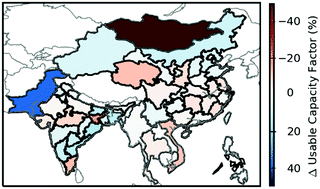Vulnerability of existing and planned coal-fired power plants in Developing Asia to changes in climate and water resources†
Abstract
Coal power generation dominates electricity supply in Developing Asia, and more than 400 gigawatts (GW) of new coal-fired capacity is planned for operation by 2030. Past studies on thermal electricity-water nexus have not accounted for this new capacity, and use coarse spatial and temporal resolutions in the assessment of long-term power system reliability. Here, high-resolution hydro-climatic simulations and asset-level power plant water use models are integrated to quantify water constraints on coal-fired power plants in Developing Asia, for different scenarios of future climate change, cooling system choice, and capacity expansion. Future climate change and capacity expansion decrease the annual usable capacity factor (UF) of coal power generation in Mongolia, Southeast Asia, and parts of India and China. The negative impacts are lessened by widening the geographic areas of aggregation. Under near-term mitigation scenarios with high penetrations of CO2 capture technology, the regional average water withdrawal intensity of coal power generation is 50–80% higher than current conditions. With careful siting, the increased water withdrawal intensity does not necessarily constrain future electricity production on annual or monthly time scales, but decreases system reliability by increasing the probability of low UF at daily time scale. Our findings highlight the unaccounted-for-risk in Developing Asia's long-term power plan featuring coal power generation. Regional capacity expansion should consider the reliability of future thermal power assets under long-term hydroclimate change using high-resolution models and multiple scenarios.



 Please wait while we load your content...
Please wait while we load your content...